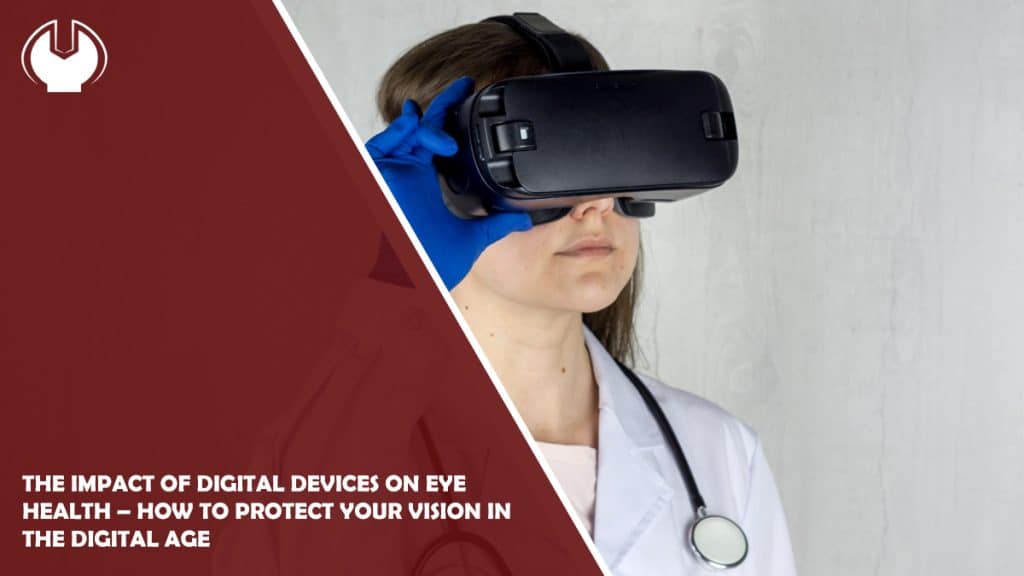In our modern world, digital devices have become an integral part of our daily lives. From smartphones and tablets to laptops and computers, we are constantly surrounded by screens. While these devices have undoubtedly revolutionised the way we live, work, and communicate, they also pose a significant threat to our eye health.
Prolonged usage of digital devices can lead to various eye-related issues collectively known as digital eye strain or computer vision syndrome. In this blog post, we will delve into the effects of prolonged digital device usage on eye health and provide practical tips to minimise digital eye strain.
The Effects of Prolonged Digital Device Usage on Eye Health
Eye Strain and Fatigue:
One of the most common effects of prolonged digital device usage is eye strain and fatigue. Staring at screens for extended periods can cause the eye muscles to become overworked, leading to discomfort, dryness, and irritation. This phenomenon is exacerbated when we forget to blink regularly, which is a common occurrence when engrossed in digital content.
Blue Light Exposure:
Digital devices emit blue light, a high-energy visible (HEV) light that has shorter wavelengths and higher energy levels. Prolonged exposure to blue light has been linked to disruptions in sleep patterns and potential damage to the retinas. Additionally, blue light exposure can contribute to eye strain and discomfort, especially when using devices late at night.
Digital Vision Syndrome:
Digital Vision Syndrome encompasses a range of symptoms caused by prolonged device usage. These symptoms may include headaches, blurred vision, double vision, and sensitivity to light. Individuals who spend significant time on digital devices are more likely to experience these issues, particularly if they do not follow proper eye care practices.
Practical Tips to Minimize Digital Eye Strain
Follow the 20-20-20 Rule:
To alleviate eye strain, incorporate the 20-20-20 rule into your digital routine. Every 20 minutes, take a 20-second break and focus on an object approximately 20 feet away. This practice helps relax the eye muscles and reduces eye fatigue caused by constant screen exposure.
Adjust Screen Settings:
Modify the brightness, contrast, and font size on your digital devices to ensure optimal visual comfort. Avoid excessively bright screens, as they can contribute to eye strain. Additionally, consider using “night mode” or blue light filters in the evening to reduce blue light exposure and improve sleep quality.
Blink Regularly:
Be mindful of blinking while using digital devices. Blinking helps keep the eyes moist and prevents dryness and irritation. Consider setting reminders or consciously making an effort to blink more often, especially during prolonged screen sessions.
Maintain Proper Distance and Posture:
Position your digital devices at a comfortable distance from your eyes, ideally around 20 to 28 inches away. Adjust the screen height to keep it at eye level, reducing strain on your neck and shoulders. Adopting an ergonomic posture can significantly contribute to overall eye comfort.
Use Anti-Glare Screen Protectors:
Invest in high-quality anti-glare screen protectors for your devices. These filters help reduce reflections and glare, enhancing visual clarity and minimising eye strain, especially in brightly lit environments.
Regular Eye Exams:
Schedule regular eye examinations with an optometrist or ophthalmologist. Comprehensive eye check-ups can identify early signs of eye issues related to digital device usage and ensure timely intervention.
Limit Screen Time:
Whenever possible, try to reduce the amount of time spent on digital devices. Take regular breaks from screens, especially during extended work or study sessions. Engage in outdoor activities and hobbies that do not involve digital screens to give your eyes a much-needed break.
Practice Eye Exercises:
Just like any other muscle in our body, our eyes benefit from exercise. Simple eye exercises, such as rolling your eyes in a circular motion or focusing on a distant object and then back on a near one, can help improve eye flexibility and reduce eye strain.
Create a Vision-Friendly Workspace:
If you spend a lot of time working on a computer, create a workspace that promotes good eye health. Ensure proper lighting, reduce glare, and adjust your monitor’s position and height to maintain a comfortable and ergonomic setup.
Consider Blue Light Glasses:
Blue light filtering glasses can be effective in reducing the amount of blue light that reaches your eyes. These specialised glasses can be worn while using digital devices, particularly during nighttime use, to minimise blue light exposure and improve sleep quality.
Encourage Healthy Digital Habits for Children:
Instilling good digital habits in children from an early age is crucial. Limit screen time for young children and encourage regular breaks during device usage. Ensure that they maintain a proper distance from screens to reduce the risk of eye strain.
Remember, taking care of your eye health is a long-term investment. While digital devices have become an integral part of our lives, it is essential to find a balance and use them responsibly. Prioritising eye health not only prevents discomfort and vision problems but also contributes to overall well-being and productivity.
If you ever experience persistent eye discomfort, blurry vision, or other concerning symptoms, do not hesitate to consult an eye care professional. Regular eye check-ups are essential, as they can detect any underlying issues and provide personalised advice on maintaining good eye health.
Summary
In conclusion, the impact of digital devices on eye health is a significant concern in today’s technology-driven world. However, by being mindful of our digital habits and adopting practical tips to minimise digital eye strain, we can protect our vision and enjoy the benefits of technology without compromising our eye health.
Let us remember that our eyes are invaluable, and preserving their health should be a priority. By making conscious choices and incorporating healthy habits into our digital routines, we can ensure that our eyes remain vibrant and well-cared for in the ever-evolving digital landscape. So, let’s take the necessary steps to safeguard our eye health and embrace a healthier and more balanced relationship with technology.
